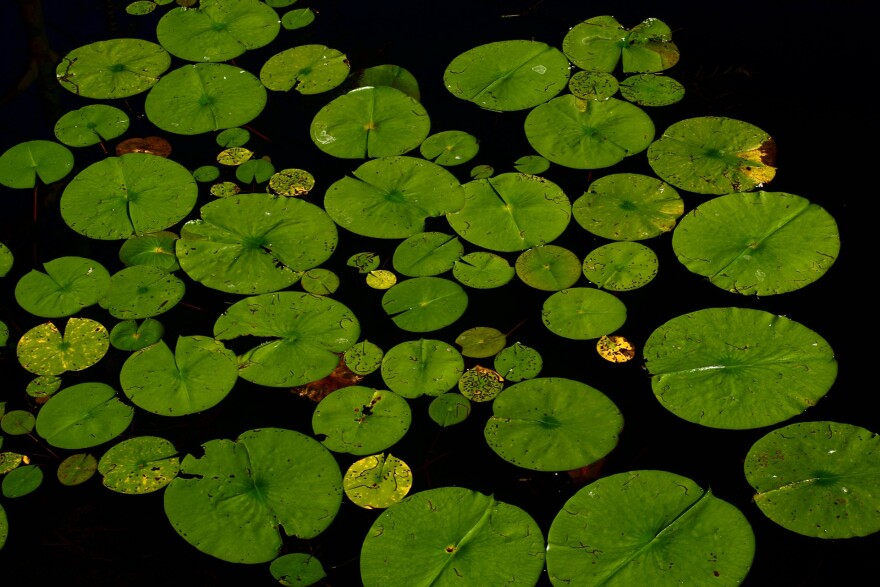Inspired by a Curious North question, this week’s Wildlife Matters finds the Masked Biologist pondering what might be causing a snapping or popping sound in and around lily pads. The answer may surprise you.
If you weren’t already aware, WXPR has a great feature called Curious North. You can submit your questions or ideas you have about a variety of topics here in the Northwoods, and staff and feature writers (like myself) help answer them. Today’s episode of Wildlife Matters was inspired by a Curious North question: What is the snapping sound that seems to go with lily pads in lakes?
As a wildlife biologist, I tend to focus more on terrestrial habitats, as that is where most of my focal species tend to live. However, shorelines are an extremely important habitat for a wide variety of wildlife, especially amphibians, waterfowl and furbearers. To know aquatic plant species is to be able to analyze water quality and wetland health. So, while I admit I am not great at deep water habitats, by necessity I have worked extensively with the shallow water zone in wetlands, lakes, and rivers. To answer this question, we start with the basics about the plant in question. Lily pads tend to grow in the shallower areas of lakes, closer to shore, in substrates that are softer, maybe muck, sand or silt. The floating leaves shade out the water and substrate below, inhibiting the growth of other aquatic plants and moderating the water temperature. The floating leaves also seem to help keep some flat water between them, at least when the wind speed is low. All of these factors combined make them the perfect location for a bug nursery, a macroinvertebrate soup or buffet if you will. Soft substrate, like silt, muck, or decomposing aquatic plants, make a great spot for aquatic insects to feed, breed, and lay eggs. These insects, in turn, attract predatory insects like dragonfly larvae. The lily pads give the insects a great way to get from the bottom up close to the surface, using the stems and bottom sides of the lily pads to graze on microscopic plant life. The lily pads also make great locations for frogs and toads to breed and lay their eggs, so egg masses and tadpoles will abound in these locations in the spring and into the summer.
So, with all that said, the snapping sound you are hearing is most likely fish—sunfish, specifically. Insects comprise a large percentage of the diet of bluegills, pumpkinseed, and redear sunfish especially this time of year. These fish like to surface feed at dawn and dusk, the times of day when boat activity is usually lower and lakes are relatively quiet. These fish feed using powerful suction, snapping their mouths open quickly, flaring their gills, generating a surprising amount of force. They come up beneath the lily pads, targeting worms, snails, and other creepy crawlies. With a gill flare, they suck their prey in with so much force that they actually tear a small circular hole in the leaf. When that happens, they break surface tension and the quick release actually makes a pop sound. You can see the evidence for yourself; if you cruise into the lilies, you can see small holes, circular cuts and dimples in the leaves. Note that hail sometimes will cause similar damage which may be visible after storms.
There are other critters feeding in the lilies as well. Bullfrogs, leopard frogs, and snapping and painted turtles come to mind. They also might be snapping at food in this nutrient rich environment. Once, I heard a strange sound in the lilies, and when I paddled my canoe closer, I saw a wood duck snapping at a seed pod trying to break it open to get to the seeds inside. Beavers and muskrats may be swimming in the area, occasionally slapping the water in alarm or making a dive. Raccoons and otters will look for clams, crayfish, frogs and just about anything else they can find. Even porcupines like to eat the salty mud and tubers of the lilies when water levels drop. So, there is a lot of activity in lily pads, from breeding to feeding. I spent some time looking online at posts from other resource professionals, and most seem to agree that it is the feeding activity of fish that you can hear. If you have seen or caught sunfish in the lilies, and see the telltale circular mouth-sized holes in the lily pads, you can be fairly confident that is what you hear.
Striving to make new things familiar and familiar things new, this is the masked biologist coming to you from the heart of Wisconsin’s great Northwoods.









